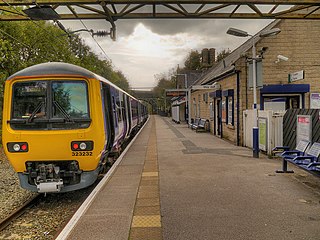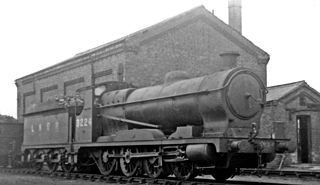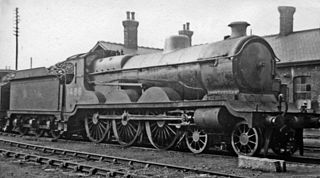John George Robinson CBE, was an English railway engineer, and was chief mechanical engineer of the Great Central Railway from 1900 to 1922.
The London and North Eastern Railway (LNER) produced several classes of locomotive, mostly to the designs of Nigel Gresley, characterised by a three-cylinder layout with a parallel boiler and round-topped firebox. It produced the most famous locomotive of its day, 4468 'Mallard', the holder of the world steam locomotive speed record. It also built the world-famous 4472 'Flying Scotsman'. However, its locomotive inheritance was much greater than just the 'A4 Class', it also produced highly successful mixed-traffic and freight designs.

The British Rail Class 76, also known as Class EM1, is a class of 1.5 kV DC, Bo+Bo electric locomotive designed for use on the now-closed Woodhead Line in Northern England.

The LNER electric units were electric multiple units that ran on the Tyneside Electrics, a suburban system based on the English city of Newcastle upon Tyne. In 1937 the London and North Eastern Railway (LNER) received articulated twin passenger electric units to replace the NER electric units that had been built in 1904–15 by the North Eastern Railway. The order including some single-unit motor parcel vans and motor luggage vans. In the 1960s declining passenger numbers and the high cost of renewing life-expired electric substation equipment across the system led to the replacement of the electric multiple units with diesel multiple units and the units were all withdrawn in 1967.

The NER Class ES1 was a class of two steeplecab electric locomotives commissioned by the North Eastern Railway in 1902.

Hadfield railway station serves the Peak District town of Hadfield in Derbyshire, England. The station is one of the twin termini at the Derbyshire end of the Manchester-Glossop Line, the other being Glossop. It was opened by the Sheffield, Ashton-under-Lyne and Manchester Railway in 1844.

The North Eastern Railway (NER) Class H, classified as Class Y7 by the London and North Eastern Railway (LNER) is a class of 0-4-0T steam locomotives designed for shunting.

The London and North Eastern Railway (LNER) Thompson Class L1 was a class of 2-6-4T steam locomotives designed by Edward Thompson. The prototype no. 9000 was built in 1945, but the remaining 99 were built under British Railways jurisdiction in the period 1948–1950.

Stephen Dewar Holden was a British engineer, the son of the engineer James Holden and succeeded his father as locomotive superintendent of the Great Eastern Railway in 1908, a post he held until his retirement in 1912.
Alexander Henderson, 1st Baron Faringdon, known as Sir Alexander Henderson, 1st Baronet, from 1902 to 1916, was a British financier and Liberal Unionist Member of Parliament.

The NER 901 Class was a class of 2-4-0 steam locomotive of the North Eastern Railway, designed by Edward Fletcher. Between 1872 and 1882 55 of the class were built for the NER.

The NER Class X was a class of 4-8-0T tank locomotive designed by Wilson Worsdell for the North Eastern Railway. They were intended for use as powerful shunting engines to arrange and move coal wagons for loading into ships. In total 15 were built, 10 by the NER between 1909 and 1910, and a further five in 1925 by the London and North Eastern Railway (LNER). They had three cylinders with divided drive: the inside cylinder driving the leading axle, the outside cylinders driving the centre.

The Class EF1 was a class of electrically powered locomotives built by the North Eastern Railway from 1914. They were built to haul coal trains from the mines at Shildon to the docks at Middlesbrough. In common with other LNER electric locomotives, no classification was given to these locomotives until 4 October 1945, when nos. 3-12 were all classified EB1 although only no. 11 was actually modified for banking. It was expected that all the locomotives would be similarly modified, but this did not happen, and the remaining locos were classified as EF1.

The North Eastern Railway Class S was a 4-6-0 type of steam locomotive designed for express passenger workings. The first example was built in 1899. They were very similar to the NER Class S1, except for the smaller wheels of the former.

The Great Central Railway (GCR) Class 8A was a class of 0-8-0 steam locomotive built between 1902 and 1911 for handling heavy coal trains over the Pennines. They all passed to the LNER in 1923, who redesignated them Class Q4. They were withdrawn from service between 1934 and 1951.
Ken Hoole (1916–1988) was an English historian known for his works on the railways of the north east of England.
The North Eastern Railway was formed by merger in 1854 and merged into the London and North Eastern Railway at the grouping in 1923. Between those dates five men held the post of Locomotive Superintendent.

The GCR Class 8F was a class of ten 4-6-0 locomotives built for the Great Central Railway in 1906 by Beyer, Peacock and Company to the design of John G. Robinson for working fast goods and fish trains. They passed to the London and North Eastern Railway at the 1923 grouping and received the classification 'B4'.

The NER Class V was a class of twenty steam locomotives of the 4-4-2 wheel arrangement. They were designed by Wilson Worsdell for the North Eastern Railway (NER) as express passenger locomotives.
The NER Class Z was an Atlantic class of locomotives designed by Vincent Raven. It was introduced in 1911.














